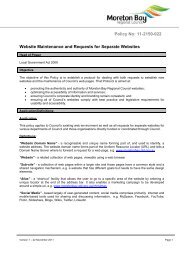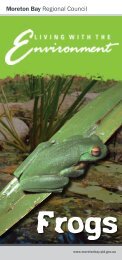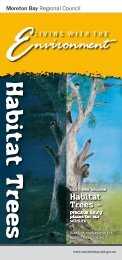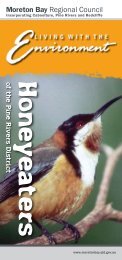Control - Moreton Bay Regional Council
Control - Moreton Bay Regional Council
Control - Moreton Bay Regional Council
Create successful ePaper yourself
Turn your PDF publications into a flip-book with our unique Google optimized e-Paper software.
Fact sheet<br />
DECLARED CLASS 2 PEST PLANT<br />
Kudzu<br />
Pueraria montana var. lobata<br />
Kudzu is a vine native to Asia. While it has been present in<br />
North Queensland for some time, kudzu has only recently<br />
been found at a few locations in South East Queensland.<br />
For some reason (possibly climatic), kudzu appears to<br />
grow much more aggressively in South East Queensland<br />
than in North Queensland.<br />
Kudzu can grow and spread rapidly, competing with, and<br />
eventually smothering, native vegetation as well as tree<br />
crops. The vines can become quite heavy, breaking any<br />
plants they happen to grow on.<br />
Left unmanaged, kudzu vines can also damage buildings,<br />
overhead wires and other structures. In the United States,<br />
kudzu causes an estimated $50 million damage each year<br />
and infests 2–3 million ha of land. If it is not controlled and<br />
prevented from spreading further in Queensland, kudzu<br />
could become a major pest here as well.<br />
Declaration details<br />
Kudzu is a declared Class 2 pest plant under the Land<br />
Protection (Pest and Stock Route Management) Act 2002 for<br />
the whole sate, except the Torres Strait Islands.<br />
A Class 2 pest is one that has already spread over<br />
substantial areas of Queensland, and its impact is so<br />
serious that we need to try and control it and avoid<br />
further spread onto properties that are still free of the<br />
pest. By law, all landholders must try to keep their land<br />
free of Class 2 pests and it is an offence to keep or sell<br />
these pests without a permit. A local government may<br />
serve a notice upon a landholder requiring control of<br />
declared pests.<br />
PP150 July 2010
Description and general information<br />
Kudzu is a perennial vine that grows rapidly and can reach<br />
20–30 m in length. Each summer, kudzu runners can grow<br />
to a length of 20 m at a rate of about 30 cm per day. Vines<br />
can climb up to 30 m, completely covering trees, buildings<br />
or other supporting objects.<br />
Kudzu has compound leaves with three broad leaflets,<br />
each up to 10 cm across. Leaves are dropped during winter<br />
in South East Queensland. The roots of kudzu are fleshy—<br />
the taproot can grow to over 1.8 m long, 15 cm in diameter<br />
and can weigh up to 180 kg.<br />
Flowers are purple to pink, fragrant, about 1–1.5 cm long<br />
and are produced in long racemes resembling pea flowers.<br />
Seeds are rarely produced but seed pods are brown, flat,<br />
hairy, 5 cm long and each pod contains 3–10 small, hard,<br />
oval seeds.<br />
Kudzu generally spreads from stolons or runners, prefers<br />
full sun and is generally intolerant of deep shade.<br />
<strong>Control</strong><br />
There is no herbicide registered for the control of kudzu<br />
in Queensland; however, off-label use permit (PER11561)<br />
allows for the use of various herbicides for the control of<br />
environmental weeds in non-agricultural areas, bushland,<br />
forests, wetlands, and coastal and adjacent areas. Refer to<br />
Table 1 for control options.<br />
Prior to using the chemicals listed under PER11561<br />
you must read or have read to you and understand the<br />
conditions of the permit. To obtain a copy of this permit<br />
contact your local council weed inspector or visit http://<br />
permits.apvma.gov.au/PER11561.PDF.<br />
It is a requirement of the permit that all persons using<br />
products covered by off-label permit comply with the<br />
details and conditions listed in that permit. Permit number<br />
PER11561 expires on 30 June 2014. While the permit may<br />
be extended beyond this date, there is no guarantee that<br />
it will, so contact your local council weed inspector for the<br />
latest information after this expiry date.<br />
2 Kudzu Pueraria montana var. lobata
Table 1. Herbicides permitted for kudzu<br />
Situation Herbicide Rate Registration<br />
status<br />
Non-crop areas<br />
non-agricultural,<br />
native vegetation<br />
and pastures<br />
(Qld) apply by<br />
ground-based<br />
application<br />
equipment only<br />
Triclopyr 600 g/L present as the<br />
butoxyethyl ester<br />
e.g. Garlon* 600<br />
Metsulfuron-methyl 600 g/kg<br />
e.g. DuPont Brush-off*<br />
Triclopyr 300 g/L present as the<br />
butoxyethyl ester<br />
Picloram 100 g/L present as the<br />
hexyloxypropylamine salt<br />
Aminopyralid 8 g/L present as<br />
the hexyloxypropylamine salt<br />
e.g. Grazon* Extra<br />
Clopyralid 300 g/L<br />
e.g. Lontrel*<br />
Imazapyr 150 g/L present as<br />
isopropylamine salt<br />
Glyphosate 150 g/L present as<br />
isopropylamine salt<br />
e.g. Arsenal Xpress<br />
Imazapyr 150 g/L present as<br />
isopropylamine salt<br />
Glyphosate 150 g/L present as<br />
isopropylamine salt<br />
e.g. Arsenal Xpress<br />
Picloram 43 g/kg<br />
e.g. Vigilant®<br />
Glyphosate 360 g/L present as<br />
isopropylamine salt<br />
e.g. Roundup®<br />
Fluroxypyr 333 g/L present as<br />
meptyl ester<br />
e.g. Starane* Advanced<br />
Fluroxypyr 333 g/L present as<br />
meptyl ester<br />
e.g. Starane* Advanced<br />
Fluroxypyr 333 g/L present as<br />
meptyl ester<br />
e.g. Starane* Advanced<br />
Fluroxypyr 333 g/L present as<br />
meptyl ester<br />
e.g. Starane* Advanced<br />
Rate for knapsack/4WD<br />
motorbike: 50 mL per 15 L water<br />
For high volume:<br />
330 mL per 10 L water<br />
10 g per 100 L plus addition<br />
of a suitable non-ionic<br />
surfactant as per label rate<br />
500 mL per 100 L water or<br />
1:200<br />
APVMA permit<br />
PER11561<br />
Permit expires<br />
30 June 2014<br />
Comments<br />
Foliar spray application<br />
Thoroughly wet all foliage<br />
to the point of run-off<br />
Foliar spray application<br />
Thoroughly wet all foliage<br />
to the point of run-off<br />
Foliar spray application<br />
Thoroughly wet all foliage<br />
to the point of run-off<br />
2 L/ha or 1:100 with water Foliar spray application<br />
Thoroughly wet all foliage<br />
to the point of run-off<br />
12.5 mL per 1 L water Foliar spray application<br />
1:1 with water Cut stem/stem injection/<br />
crowning<br />
Use undiluted<br />
Apply directly to cut<br />
surface of stem<br />
Cut stem/stem injection/<br />
crowning<br />
Apply directly to cut<br />
surface of stem<br />
1:2 with water Cut stem/stem injection/<br />
crowning<br />
Apply directly to cut<br />
surface of stem<br />
300 mL per 100 L water Foliar spray application<br />
1:20 with water Cut stem/stem injection/<br />
crowning<br />
Apply directly to cut<br />
surface of stem<br />
1:30 with kerosene Basal bark application<br />
Use undiluted<br />
Cut stem/crowning<br />
APVMA off-label permit – PER11561: Herbicides for the control of kudzu (pueraria montana var. lobata) in non-agricultural, native vegetation and<br />
pastures (Qld) apply by ground-based application equipment only.<br />
It is a requirement of a permit that all persons using the products covered by this off-label permit comply with the details and conditions listed in the<br />
permit. In addition, read the herbicide label carefully before use and always use the herbicide in accordance with label directions. The above permit<br />
can be used by persons general.<br />
3 Kudzu Pueraria montana var. lobata
Before using any herbicide, read the label carefully and<br />
always use the herbicide strictly in accordance with label<br />
and permit directions.<br />
For successful control of kudzu, the extensive root system<br />
must be destroyed. Cattle and goats can successfully graze<br />
on the leaves, which allow access to destroy the tubers.<br />
Manual control<br />
Seedlings and smaller plants can be hand pulled. Ensure<br />
tubers are all dug up. Bag and dispose of this pest plant at<br />
the local garbage dump, but never place in green waste.<br />
Wear gloves, as the leaves and stems are hairy and may<br />
cause skin irritation.<br />
Herbicide control<br />
Chemical control, such as foliar spray, may be required for<br />
larger infestations of kudzu. See Table 1 for details.<br />
Further information<br />
Further information is available from your local<br />
government office, or by contacting Biosecurity<br />
Queensland (call 13 25 23 or visit our website at<br />
www.biosecurity.qld.gov.au).<br />
Fact sheets are available from Department of Employment, Economic Development and Innovation (DEEDI) service centres and our Business<br />
Information Centre (telephone 13 25 23). Check our website at www.biosecurity.qld.gov.au to ensure you have the latest version of this fact sheet.<br />
The control methods referred to in this fact sheet should be used in accordance with the restrictions (federal and state legislation, and local<br />
government laws) directly or indirectly related to each control method. These restrictions may prevent the use of one or more of the methods referred<br />
to, depending on individual circumstances. While every care is taken to ensure the accuracy of this information, DEEDI does not invite reliance upon it,<br />
nor accept responsibility for any loss or damage caused by actions based on it.<br />
© The State of Queensland, Department of Employment, Economic Development and Innovation, 2010 PR10–5201


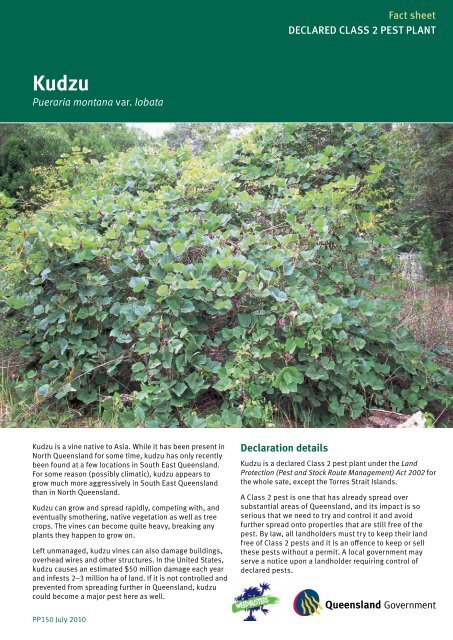
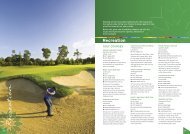

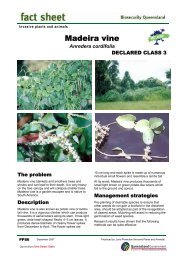
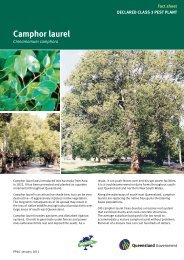


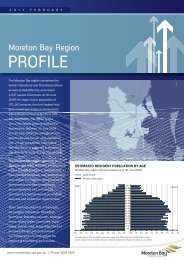
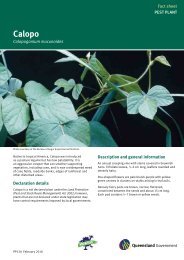

![Kumbartcho Brochure [PDF 540KB] - Moreton Bay Regional Council](https://img.yumpu.com/47220970/1/190x101/kumbartcho-brochure-pdf-540kb-moreton-bay-regional-council.jpg?quality=85)
